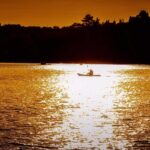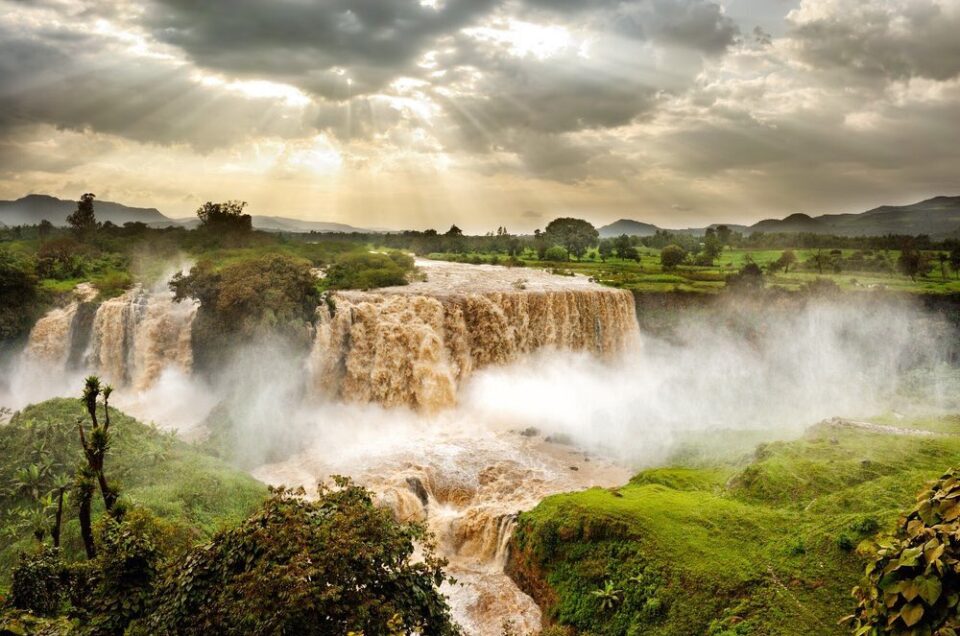The Blue Nile Falls tops the list of must-see tourist attractions in Ethiopia. Also known as Tis Abay, meaning ‘great smoke’, the waterfall cascades from a height of some 42 meters and explodes in clouds of mist as it crashes to the surface. An impressive sight.
The River Nile in Ethiopia
The Blue Nile is one of the 2 tributaries which make up the River Nile, Africa’s longest river. An international river, the Nile traverses through 11 countries and is the main source of water for both Eygpt and Sudan.
Originating at Lake Tana in Ethiopia, 18.6 miles (30 km) from the town of Bahir Dar, the Blue Nile meets the White Nile in Sudan before meandering north through Egypt and eventually spilling into the Mediterranean Sea.

Why is the Blue Nile called the Blue Nile?
During the summer monsoons, fertile land is eroded from the Ethiopian highlands and carried along by the Blue Nile as silt. The resulting dark, almost black, appearance gives rise to the name, The Blue Nile.
This hue is in stark contrast to the light grey color of the White Nile which is tinted by light-colored clay sediment.
How to Get to the Blue Nile Falls
The starting point for a visit to the Blue Nile Falls is the town of Bahir Dar which is itself well worth exploring.
Home to a staggering 37 monasteries dating back to the 16th and 17th centuries, Bahir Dar provides a fascinating glimpse into the country’s rich religious and cultural history.
Accessing the Blue Nile Falls from Bahir Dar
The Blue Nile is located 22 miles (35 kilometers) from Bahir Dar.
A car or bus journey of around 30 minutes leads to the village of Tis-Isat where the ticket office is located. The ticket office is open from 7:30 until 17:30 and tickets are priced at 50 birr per adult (under 2 USD).
Should they wish to do so, visitors can also pay for a guide to lead the way to the falls whilst offering an insight into the history of the area.
How to get to the Blue Nile Falls from Tis-Isat
Visitors have 2 options for accessing the falls from Tis-Isat.
The first route is via a 17th century fortified bridge built by Portuguese explorers—the first bridge to span the river and still in use today. The steep path then winds through villages and hamlets. Offering impressive views, this route is a great option for keen photographers.
The second route avoids the steep incline and instead involves a boat river crossing followed by a flat 20-minute walk. Boat services run daily from 7am until 6pm but visitors should be aware that the service may be canceled on days when the river is flowing particularly quickly. By taking this route tourists are able to walk behind the water curtain and even swim in the pool at the base.
The return trip can be made by taking the same journey in reverse or, as is more commonly done, combining the 2 different routes to create a circuit.
Measuring around 3 miles (1.5 km) in total, this circuit is a fantastic way to fully appreciate the stunning landscape and offers many fantastic photo opportunities.

Highlights of a Trip to the Blue Nile Falls
As well as the waterfall itself, visitors will be delighted along the route by:
- Wildlife. The area surrounding the falls is home to a wide range of wildlife, including monkeys and a mirage of brightly colored birds.
- Villages and hamlets. The path to the falls passes by small villages and hamlets which offer an insight into Ethiopian culture and village life.
- Mist and rainbows. As the water crashes down it creates huge plumes of mist and beautiful rainbows are formed.
- Scenic views. Surrounded by stunning nature, there are many excellent photographic opportunities along the route.
When is the Best Time of Year to Visit the Blue Nile Falls?
Hydroelectric power stations upstream use up some of the waterfall’s power. To avoid disappointment visitors should therefore carefully consider the timing of their trip.
The best times to see the Blue Nile Falls are explained below.
When to see the Blue Nile Falls at its best
To see the waterfall at its biggest and best, tourists are recommended to visit in the wet season, August and September are particularly good months.
The heavy downpours during the rainy season ensure that the river is sufficiently topped-up to offer a spectacular cascade.
For holidaymakers in Ethiopia at any time of year other than August and September, the Blue Nile Falls, although not as powerful, is still worth a visit because of the beautiful natural surroundings.
When to avoid visiting the Blue Nile Falls
It is not advised to go to the Blue Nile Falls during the dry season.
From the beginning of the year until around March the lack of rainfall means that the waterfall is far less impressive. In fact, during this period the waterfall is commonly known as the Blue Nile Shower.
What to Pack for a Trip to the Blue Nile Falls
It is recommended that tourists take the following items with them on a trip to the Blue Nile Falls:
- Waterproof coat to keep dry from the spray of the waterfall
- Camera for capturing the beautiful scenery
- Binoculars to see the wildlife up close
- Comfortable walking shoes




